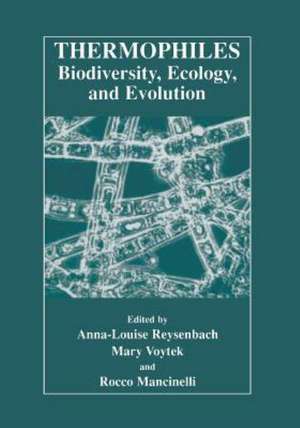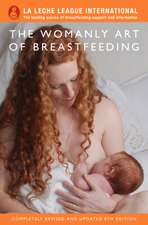Thermophiles: Biodiversity, Ecology, and Evolution: Biodiversity, Ecology, and Evolution
Editat de Anna-Louise Reysenbach, Mary Voytek, Rocco Mancinellien Limba Engleză Paperback – 17 sep 2012
| Toate formatele și edițiile | Preț | Express |
|---|---|---|
| Paperback (1) | 715.35 lei 6-8 săpt. | |
| Springer Us – 17 sep 2012 | 715.35 lei 6-8 săpt. | |
| Hardback (1) | 724.29 lei 6-8 săpt. | |
| Springer Us – 28 feb 2001 | 724.29 lei 6-8 săpt. |
Preț: 715.35 lei
Preț vechi: 753.01 lei
-5% Nou
Puncte Express: 1073
Preț estimativ în valută:
136.90€ • 142.40$ • 113.02£
136.90€ • 142.40$ • 113.02£
Carte tipărită la comandă
Livrare economică 14-28 aprilie
Preluare comenzi: 021 569.72.76
Specificații
ISBN-13: 9781461354369
ISBN-10: 1461354366
Pagini: 232
Ilustrații: XXI, 205 p.
Dimensiuni: 178 x 254 x 12 mm
Greutate: 0.41 kg
Ediția:Softcover reprint of the original 1st ed. 2001
Editura: Springer Us
Colecția Springer
Locul publicării:New York, NY, United States
ISBN-10: 1461354366
Pagini: 232
Ilustrații: XXI, 205 p.
Dimensiuni: 178 x 254 x 12 mm
Greutate: 0.41 kg
Ediția:Softcover reprint of the original 1st ed. 2001
Editura: Springer Us
Colecția Springer
Locul publicării:New York, NY, United States
Public țintă
ResearchCuprins
1 The Origins of Research on Thermophiles.- 1. Introduction.- 2. Early Bacteriological Research on Thermophiles.- 3. Ecological Observations of Geothermal Environments.- 4. Yellowstone National Park.- 5. Thermus Aquaticus.- 6. Discovery of Extreme Thermophiles.- 7. Thermoplasma, Sulfolobus, and the Archaea.- 8. Yellowstone Research and the Deep-Sea Thermal.- 9. Microbial Prospecting in Thermal Habitats.- 10. Conservation of Yellowstone’s Thermal Resources.- 11. Summary.- References.- 2 Deep-Sea Thermophilic Prokaryotes.- 1. Introduction.- 2. Hydrothermal Vent Environments.- 3. Biological Communities.- 4. Ecological Studies.- 5. Diversity: Thermophilic and Hyperthermophilic Isolates.- 6. Assessments of Molecular Diversity.- 7. Bioprospecting and Biotechnology.- 8. Hydrothermal Vents and the Origin of Life.- 9. Summary.- References.- 3 Biodiversity of Acidophilic Moderate Thermophiles Isolated from Two Sites in Yellowstone National Park, and Their Roles in the Dissimilatory Oxido-Reduction of Iron.- 1. Introduction.- 2. Materials and Methods.- 3. Results.- 4. Discussion.- 5. Summary.- References.- 4 Presence of Thermophilic Naegleria Isolates in the Yellowstone and Grand Teton National Parks.- 1. Introduction.- 2. Materials and Methods.- 3. Results.- 4. Discussion.- 5. Summary.- References.- 5 Examining Bacterial Population Diversity Within the Octopus Spring Microbial Mat Community.- 1. Introduction.- 2. Octopus Spring Mat Cyanobacterial Diversity as Revealed by Microscopy, Cultivation, Probing, Cloning, and Sequencing.- 3. Standardization of Methodology, Environmentally Meaningful Sampling Points, and Increased Sample Throughput are Necessary to Understand Octopus Spring Population Dynamics.- 4. DGGE Analysis of Octopus Spring Mat Samples.- 5. DGGE Analyses of AerobicChemoorganotrophic Enrichment Cultures Demonstrates the Incongruence among Populations within Natural Microbial Communities and Those Obtained from Selective Enrichment Cultures.- 6. Summary.- References.- 6 Direct 5S rRNA Assay for Microbial Community Characterization.- 1. Introduction.- 2. Materials and Methods.- 3. Results.- 4. Discussion.- 5. Summary.- References.- 7 Community Structure Along a Thermal Gradient in a Stream near Obsidian Pool, Yellowstone National Park.- 1. Introduction.- 2. Materials and Methods.- 3. Results.- 4. Discussion.- References.- 8 Isolation of Hyperthermophilic Archaea Previously Detected by Sequencing rDNA Directly from the Environment.- 1. Introduction.- 2. Materials and Methods.- 3. Results.- 4. Summary.- References.- 9 Thermophilic Anoxygenic Phototrophs Diversity and Ecology.- 1. Introduction.- 2. Diversity and Phylogeny of Hot Spring Anoxyphototrophs.- 3. Physiology of Hot Spring Anoxyphototrophs.- 4. Ecological Studies of Thermophilic Anoxyphototrophs.- 5. Conclusions.- References.- 10 Algal Physiology at High Temperature, Low pH, and Variable pC02 Implications for Evolution and Ecology.- 1. Introduction: Why the Microbial Mats of Yellowstone.- 2. Material and Methods.- 3. Results.- 4. Discussion.- 5. Summary.- References.- 11 The Zonation and Structuring of Siliceous Sinter Around Hot Springs, Yellowstone National Park, and the Role of Thermophilic Bacteria in Its Deposition.- 1. Introduction.- 2. Geologic Setting of Yellowstone Geothermal System.- 3. Morphological Subdivisions of Outflow Systems.- 4. Temperature and Bacterial Subdivisions of Outflow Systems.- 5. The Role of Bacteria in the Deposition and Structuring of Siliceous Sinter.- 6. Discussion.- 7. Summary.- References.- 12 Use of 16S rRNA, Lipid, and Naturally PreservedComponents of Hot Spring Mats and Microorganisms to Help Interpret the Record of Microbial Evolution.- 1. Introduction.- 2. 16S rRNA Biomarker Studies Link Biodiversity, Ecology, and Evolution.- 3. Lipid Biomarker Studies Help Link Chemical Fossils to Their Microbial Sources.- 4. Naturally Preserved Biomarkers can be Related to Their Microbial Sources.- 5. Summary.- References.- 13 Research Accomplishments of a Small Business Using Yellowstone’s Extremophiles.- 1. Introduction.- 2. Results and Discussion.- 3. Conclusions.- References.- 14 The Yellowstone Microbiology Program Status and Prospects.- 1. Introduction.- 2. Inventory and Monitoring of YNP Microorganisms.- 3. Microbiological Research Support.- 4. Protection of Geothermal Habitat.- 5. Benefit-Sharing/Bioprospecting.- 6. Education.- 7. Summary.- Appendix I.- Appendix II.- References.









